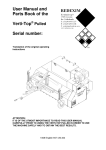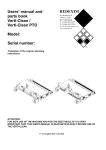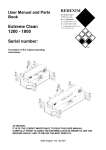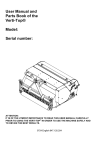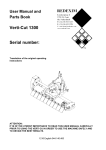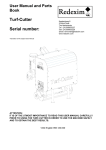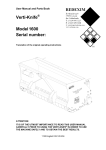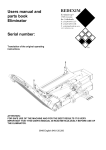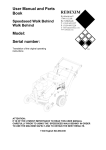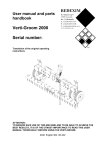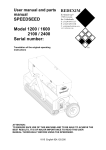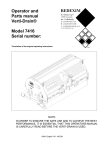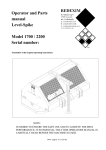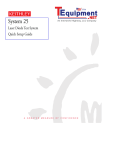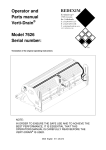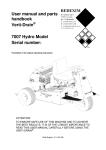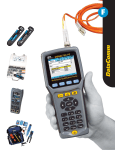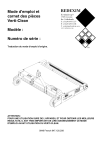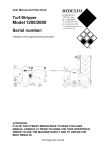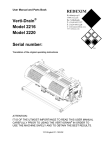Download User Manual and Parts Book of the Verti
Transcript
User Manual and Parts Book of the Verti-Top Walk Behind® Model: Serial number: ATTENTION: IT IS OF THE UTMOST IMPORTANCE TO READ THIS USER MANUAL CAREFULLY PRIOR TO USING THE VERTI-TOP WALK BEHIND® IN ORDER TO USE THE MACHINE SAFELY AND TO OBTAIN THE BEST RESULTS. 0948 English 947.120.206 FOREWORD Congratulations on your Verti-Top Walk Behind purchase! For safe and long-lasting operation of this Verti-Top Walk Behind, it is necessary to read and to understand this user manual. It is impossible to work safely with this machine without complete knowledge of its content. The following pages deal initially with the general safety instructions. Every user should know these safety instructions and apply them. At the end of this page, a registration card is inserted. This registration card should be returned to enable us to deal with potential future claims. This user manual lists many instructions that are numbered in sequence. You should follow this sequence. A is an indication of a safety instruction. A means a tip and/or note. All information and technical specifications provided at the moment that this document is published are the most recent ones. Design specifications may be changed without prior notice. This document is a translation of the original operating instructions. Upon request, the original operating instructions are available in Dutch. WARRANTY CONDITIONS WITH DELIVERY THIS VERTI-TOP WALK BEHIND IS GUARANTEED AGAINST MATERIAL DEFECTS. THIS WARRANTY IS VALID FOR A PERIOD OF 12 MONTHS FROM THE PURCHASE DATE. VERTI-TOP WALK BEHIND WARRANTIES ARE SUBJECT TO THE ‘GENERAL CONDITIONS FOR SUPPLY OF PLANT AND MACHINERY FOR EXPORT, NUMBER 188’ THAT ARE PUBLISHED UNDER THE AUSPICES OF THE UNITED NATIONS ECONOMIC COMMISSION FOR EUROPE. REGISTRATION CARD For your own information, fill in the table below: Serial number machine Dealer name Date of purchase Remarks 2 SAFETY INSTRUCTIONS Figure 1 (1) The Verti-Top Walk Behind is designed for safe use. This can only be achieved if you completely follow the safety instructions described in this manual. Read and understand (Figure 1) the manual before you start using the Verti-Top Walk Behind. If the machine is not used as described in this manual, this can result in injuries and/or damage to the Verti-Top Walk Behind. The user must be an expert in using the machine. The machine should be professionally adjusted for cultivating the subsoil. The manufacturer will not accept any liability for unprofessional use and its resulting damage. All risks occurring with this are entirely at the expense of the user. Not following the use, maintenance and repair instructions prescribed by the manufacturer is also considered unprofessional use of this machine. Inspect the area to be treated before using the Verti-Top Walk Behind. Remove loose obstacles and avoid irregularities. (2) The Verti-Top Walk Behind is manufactured according to the latest technical understanding and is safe to use. When careless people use, maintain or repair the machine, danger of injuries to the user and to third parties can be the result. This must be avoided! (3) All persons assigned to operate, maintain and repair the Verti-Top Walk Behind by the owner must completely read and understand the operation manual and in particular the chapter of Safety Instructions. The user is responsible for safe use of the Verti-Top Walk Behind. (4) The user is obliged to check the Verti-Top Walk Behind for visible damage and defects before using the Verti-Top Walk Behind. Modifications to the Verti-Top Walk Behind (including its operations) that have a negative impact on safety must be rectified immediately. For safety reasons it is in principle not permitted to make changes or adjustments to the Verti-Top Walk Behind (except those approved by the manufacturer). 3 If modifications to the Verti-Top Walk Behind have been made, then the current CE marking is cancelled. The person that has made these modifications has to apply for a new CE marking himself. Check the Verti-Top Walk Behind for loose bolts, nuts and components before every operation. If present, check the hydraulic pipelines regularly and replace these when the hydraulic pipelines are damaged or appear old. The replacing pipelines should comply with the technical requirements of the manufacturer. If present, you should always make the hydraulic installation pressure-free before working on this installation. NEVER use the Verti-Top Walk Behind in the absence of protective guards and safety stickers. The inspection hatch MUST be closed when using the Verti-Top Walk Behind (Figure 2). Figure 2 NEVER crawl under the Verti-Top Walk Behind. If necessary, tilt the Verti-Top Walk Behind. In case of maintenance, adjusting and repairs, it is necessary to block the Verti-Top Walk Behind in order to prevent sinking away, driving off and/or sliding off. ALWAYS switch off the motor and detach the spark plug cable from the spark plug in case of maintenance, adjustments and repairs (Figure 4). Fig. 4 With regards to the safety of the machine and the user, use only original Verti-Top Walk Behind parts for maintenance and repairs. 4 Only authorised technical personnel may carry out repairs to the Verti-Top Walk Behind. Keep a record of the repair activities. (5) The general applicable health & safety (Dutch acronym: ARBO) regulations must also be followed in addition to the instructions in this user manual. Relevant traffic regulations also apply in case of using public roads. Transporting persons is not permitted! Do not use the Verti-Top Walk Behind in the dark, in heavy rain/storm or on slopes with an angle larger than 20 degrees. (6) All persons that are going to operate the Verti-Top Walk Behind must be familiar with all the functions and control elements of the Verti-Top Walk Behind before starting any work activities. Safety stickers with an identical meaning are attached to the sideboard, and near the front and rear cover (Figure 8) of the Verti-Top Walk Behind. These safety stickers must always be clearly visible and legible and must be replaced in case they have become damaged. During operation, NO persons without the proper protection gear are allowed within the danger zone of the Verti-Top Walk Behind, because there is danger of physical injuries caused by flying particles or substances (Figure 5). Figure 6 Figure 5 Onlookers without personal protection gear must keep a distance of minimum 4 metres! (Figure 6) 5 Dress appropriately. Wear sturdy shoes with steel toecaps, long trousers and tie up long hair. Do not wear loose clothing. Use the proper personal protection gear according to the applicable health & safety (Dutch acronym: ARBO) and safety regulations. Figure 7 Use certified ear protection when using the machine! (Figure 7) Figure 8 (7) Location of the safety stickers (Figure 8). 6 TABLE OF CONTENTS 1.0 2.0 3.0 4.0 5.0 6.0 7.0 8.0 9.0 10.0 11.0 12.0 12.1 12.2 13.0 FOREWORD................................................................................................................. 2 WARRANTY CONDITIONS .......................................................................................... 2 REGISTRATION CARD ................................................................................................ 2 SAFETY INSTRUCTIONS ............................................................................................ 3 TECHNICAL DATA ....................................................................................................... 8 FIRST INSTALLATION – TAKING THE MACHINE OFF THE PALLET......................... 9 LIST OF GENERAL COMPONENTS ...........................................................................10 ADJUSTING THE WORKING DEPTH OF THE BRUSH ..............................................11 ADJUSTING THE ANGLE OF THE JIGGING SIEVE ...................................................12 TRANSPORTING THE VERTI-TOP WALK BEHIND ...................................................13 USING THE VERTI-TOP WALK BEHIND ....................................................................13 START/STOP PROCEDURE .......................................................................................14 EMPTYING THE WASTE RECEPTACLE ....................................................................16 TROUBLE SHOOTING (PROBLEM ANALYSIS) .........................................................17 EU DECLARATION......................................................................................................17 MAINTENANCE ...........................................................................................................18 ADJUSTING THE TENSION OF THE V-BELTS ..........................................................19 CHANGING THE JIGGING SIEVE...............................................................................21 OPTIONS FOR OTHER JIGGING SIEVES..................................................................22 7 1.0 TECHNICAL DATA Model V-Top WB Working width 800mm Working depth (In case of a nonworn brush) Speed 0 mm-10mm (0”-0.4”) Weight 0 – 3.5 km/h 0 – 2.5 mph 150 kg (330 lbs) Content of the receptacle 30 litres (1830.7 cu. inch) Maximum capacity 2800 m2/h (30139 ft2/h) (Theoretical at maximum speed of 3.5 km/h [2.5mph]) Motor Briggs and Stratton 6.5 HP Mesh of jigging sieve 5 mm x 5 mm (0.2 “ x 0.2”) (Standard supplied) Transport dimensions LxWxH 1,070 x 1,035 x 1,305 mm 42.1” x 40.7” x 51.4” Oil gearbox SAE 30 Motor oil SAE 30 Standard components Jigging sieve, adjustable according to cleaning level Removable waste receptacle Easily exchangeable sieve Cylinder for the manual including a manual Optional Sieve elements with various mesh dimensions 8 2.0 FIRST INSTALLATION – TAKING THE MACHINE OFF THE PALLET 1 2 3 4 6 5 7 Figure 9 The machine in transport position is delivered on a pallet. To remove the pallet and to prepare the machine, you take the following steps (see Figure 9): NEVER crawl under the machine! 1. 2. 3. 4. 5. Remove the straps (1) with which the machine is fixed to the pallet. Open the inspection hatch (4). Remove the bolt and nut (2) on both sides of the machine. Lower the handlebar (3) and mount bolts and nuts (2) when the correct position has been reached. Attach a cable to the lifting eyes (5 and 6). Make sure that the cable/crane/lift can hoist minimum 200 kg (441 lbs). 6. Lift the machine off the pallet (7). WATCH OUT AND KEEP YOUR DISTANCE! 7. Lower the machine controlled and calmly until it stands completely on the subsoil. 9 3.0 LIST OF GENERAL COMPONENTS Figure 10 shows several important components: 16 14 9 2 15 1 3 11 6 5 17 2 4 9 8 10 13 12 7 Figure 10 1. 2. 3. 4. Safety sticker 900.280.402; first read the user manual / toolbox before using it. Safety sticker 933.280.402; onlookers without personal protection gear must keep a distance of 4 metres from the machine. Switch off the motor and detach the spark plug cable from the spark plug in case adjustment or repair is necessary. Watch out for flying particles! The serial number is located at the front side of the machine. Safety sticker 911.280.404; the inspection hatch MUST be closed when using the machine. All the safety stickers should be on the machine at all times and should be understood. 5. 6. 7. 8. 9. 10. 11. 12. 13. 14. 15. 16. 17. Adjustment device for adjusting the working depth Knob for adjustment to the transport position Waste receptacle Jigging sieve adjustable according to cleaning level Adjusting handle of the angle of the jigging sieve ON/OFF switch Choke Start cord Fuel valve Throttle Drive handle Clutch handle of drive mechanism Rotating brush 10 1 Figure 11 4.0 ADJUSTING THE WORKING DEPTH OF THE BRUSH The working depth of the brush can be adjusted by adjusting the stellar knob at the front side of the machine. The procedure is as follows (see Figure 11): Make sure that the Verti-Top Walk Behind is blocked well and cannot move on its own accord! Switch off the Verti-Top Walk Behind before making adjustments! 1. If this has not been done yet, put the spindle in the upper position of the slotted hole. 2. Turn the spindle (1) until the correct position has been reached. NEVER adjust the machine in such a way that it could damage the subsoil. IMPORTANT! First check the working depth on the subsoil statically before using the machine! Experience shows that the machine adjustment for top-layer cleaning is best if the brush hairs just don’t touch the grass fibres. 11 5.0 ADJUSTING THE ANGLE OF THE JIGGING SIEVE 3 2 1 Figure 12 If the receptacle is catching too much material that should have been sieved, it is possible to allow the jigging sieve more time for sieving the material. This is done by placing the jigging sieve under an angle. The procedure is as follows (see Figure 12): Make sure that the Verti-Top Walk Behind is blocked well and cannot move on its own accord! Switch off the Verti-Top Walk Behind before making adjustments! 1. Open the inspection hatch (1). 2. Loosen the stellar knobs (2) one turn on both sides of the machine. 3. Adjust the jigging sieve so that it is parallel and at the required angle. For this purpose, make use of the indication stickers (3). It is important that the jigging sieve is parallel adjusted on both sides of the machine; if this is not done, you can damage the machine. 4. Tighten the stellar knobs (2) on both sides of the machine. 5. Close the inspection hatch (1). 12 6.0 TRANSPORTING THE VERTI-TOP WALK BEHIND 2 1 3 Figure 13 For transporting the machine, it is equipped with an easily adjustable special transport position causing the brush to run freely from the subsoil. The major advantage of the transport position is that the original working depth setting is maintained so that you can continue working after switching to the processing position. Adjustment is carried out as follows (see Figure 13): Make sure that the Verti-Top Walk Behind is blocked well and cannot move on its own accord! Switch off the Verti-Top Walk Behind before making adjustments! 1. 2. 3. 7.0 Loosen the stellar knobs (1) on both sides of the machine. Adjust the front side of the machine using handgrip (2) so that it tilts backwards and the stellar knobs (1) are in position 3. Tighten the stellar knobs (1) on both sides of the machine. USING THE VERTI-TOP WALK BEHIND Before using the Verti-Top Walk Behind in a location, you should check the following items: 1. 2. 3. 4. 5. 6. Are there loose objects in the field? First remove these objects. Are there slopes? The maximum slope is 20 degrees for the Verti-Rake. Always go from top to bottom. Is there danger of flying objects (e.g., golf balls) that distract the attention of the driver? If so, the Verti-Top Walk Behind CANNOT be used. Is there danger of sinking/sliding away? If so, postpone the processing until conditions improve. If the soil is wet, postpone the activities until conditions improve. A field can be worked several times in the same or different directions in order to obtain better cleaning. 13 1 3 2 Figure 14 8.0 START/STOP PROCEDURE The start procedure is VERY important. If this procedure is not executed as described below, serious damage to the machine / subsoil could be the result. The start procedure is as follows (see Figure 14): 1. Check the Verti-Top Walk Behind for loose components and look whether all components function properly. If loose components are observed or components do not function properly, the problems must be solved before using the Verti-Top Walk Behind! 2. Drive to the spot where the processing should take place. Make sure that the Verti-Top Walk Behind is blocked well and cannot move on its own accord! Switch off the Verti-Top Walk Behind before making adjustments! 3. Put the machine in the processing position and adjust the working depth of the machine statically as described in Chapter 4.0. Wear the proper personal protection gear! 4. Start the motor with a low number of revolutions. (Please refer to the supplied motor manual for the start procedure of the motor.) 5. Pull the drive handle (1) towards the handlebar: The machine will move forward. 6. Increase the number of revolutions to the maximum by adjusting the throttle (2). 14 The drive should be disengaged for pulling the machine backwards. The procedure is as follows (see Figure 14): 1. Release the drive handle (1): The drive will disengage. 2. Decrease the number of revolutions by adjusting the throttle (2). Wait until the machine comes to a standstill before disengaging; if this is not done, you can cause severe damage / wear & tear to the clutch! 3. Pull the clutch handle (3) backwards so that the machine is released. 4. Manoeuvre until it winds up in the correct position. 5. Move the clutch handle (3) forward and push the machine slightly forward; the clutch will re-engage automatically. 6. Pull the drive handle (1) towards the handlebar: The machine will move forward. 7. Increase the number of revolutions by adjusting the throttle (2). Stopping occurs as follows (see Figure 14): 1. Release the drive handle (1): The drive will disengage. 2. Decrease the number of revolutions by adjusting the throttle (2). 3. Stop de motor. The Verti-Top Walk Behind is standard adjusted to drive straight. This can easily be adjusted so that short bends can be taken (e.g., for cleaning around a pole). The procedure is as follows (see Figure 15): 1 Figure 15 1. Loosen the stellar knobs (1) and remove them. Now the front wheels can turn so that you can take bends. Take bends carefully so that damage to the subsoil is avoided. 15 9.0 EMPTYING THE WASTE RECEPTACLE 1 2 3 Fig. 16 The waste receptacle should be emptied when the receptacle is full. The procedure is as follows (see Figure 13): 1. Drive the Verti-Top Walk Behind to the waste-collection dump. Make sure that the Verti-Top Walk Behind is blocked well and cannot move on its own accord! Switch off the Verti-Top Walk Behind before proceeding! 2. 3. 4. 5. 6. 7. Open the rear inspection hatch (1). Remove the pin and safety clip (2). Remove the waste receptacle (3) and empty it. Hang the waste receptacle (3) back in the machine. Mount the pin and safety clip (2) so that the waste receptacle (3) is fixed. Close the inspection hatch (1). Remove waste according to the applicable stipulations of the local legislation. 16 10.0 TROUBLE SHOOTING (PROBLEM ANALYSIS) Problem The waste receptacle has collected too much material that needs to be cleaned Possible cause - Jigging sieve is adjusted too flat - - Working depth is adjusted too deep Jigging sieve is clogged Surroundings are too wet Jigging sieve has a mesh that is too small - - Too little cleaning Solution - Sloppy image of the field after processing Working depth is adjusted too shallow Sieve with too large a mesh Brush is worn out Outlet opening of the brush is blocked V-belts are slipping - Adjust the jigging sieve more under an angle (see Ch. 5.0) Adjust the machine to less depth Clean the jigging sieve Wait till surroundings are dried up. Use a sieve with a larger mesh. Adjust the machine to more depth Replace sieve with a smaller meshed sieve Replace brush Remove blockage - Span the V-belts and/or adjust the idler tension pulley (see Ch. 12.1) Machine is adjusted too deep - Adjust the machine to less depth Squeaking noises during the machine’s operation - Bearings are worn out - Replace the bearings Clutch for reversing doe not release - Cable is stretched / worn out Clutch housing is damaged - Adjust and/or replace the cable Repair and/or replace the parts Machine does not move - - V-belts are slipping - - V-belts are burnt Defect in the mechanical driveline - Span the V-belts and/or adjust the idler tension pulley (see Ch. 12.1) Replace the V-belts Repair and/or replace the parts 11.0 EU DECLARATION We – Redexim BV, Utrechtseweg 127, 3702 AC Zeist, Holland – declare entirely under our own responsibility that the product VERTI-TOP WALK BEHIND with a machine number as indicated on the machine and indicated in this manual to which this declaration relates is according to the stipulation of the 2006/42/EC directive for machines. Zeist, 01/10/09 A.C. Bos Manager Operations & Logistics Redexim Holland 17 12.0 MAINTENANCE Time Schedule Before every use Check/Grease Point Method - Check for loose bolts/nuts - - Presence and readability of the safety stickers - Tighten loose bolts/nuts with the correct tightening moment Replace these if not present or damaged (Please refer to Figure 8) After the first 20 working hours (new or repaired) - After every 100 working hours or annually Check the roller bearings and the driveline Check for loose bolts/nuts - If required, replace the parts - Tighten loose bolts/nuts with the correct tightening moment - Check the tension of the V-belts - If necessary, adjust the tension of the V-belts (see Ch. 12.1) - Check the roller bearings and the driveline Check for loose bolts/nuts - If required, replace the worn parts - Tighten loose bolts/nuts with the correct tightening moment Adjust the tension of the chain or – if required – replace the chain Adjust the tension of the V-belts (see Ch. 16.1) or – if required – replace the V-belts If necessary, replace the brush Use a universal chain grease - Check the tension of the chain in the driveline - - Check the tension / wear of the V-belts - - Check the wear of the brush Grease the drive chain - - - Please refer to the supplied manual for maintenance of the motor/gearbox! 18 12.1 ADJUSTING THE TENSION OF THE V-BELTS A 4 5 1 2 3 Figure 17 The Verti-Top Walk Behind is standard equipped with adjustable tension pulleys that keep the Vbelts taut. The system can be divided into 2 segments. 1. Tension pulley for the drive of the brush (see Figure 17) 2. Variable tension pulley for the drive of the entire machine (1) (see Figure 18) Depending on the intensity of using the machine, wear and tear can occur to the driveline resulting in slipping of the V-belts. These V-belts should then be tightened. Adjusting the tension pulleys is done as follows: Make sure that the Verti-Top Walk Behind is blocked well and cannot move on its own accord! Switch off the Verti-Top Walk Behind before proceeding! 1. Detach the spark plug cable (1) from the spark plug. 2. Remove all nuts (2) and the safety cap (3). Tension pulley for the drive of the brush (see Figure 17) 1. Loosen the nut (4) slightly so that the tension is just off. 2. Adjust the tension pulley (5) until the correct tension has been reached. 3. Check the tension of the V-belt by pulling on point A with a tension of 2.5 kg (5.5lbs). The stretch should be 2 mm (0.08”). 4. Tighten the nut (4). 5. Return the safety cap (3) to its location and mount all nuts (2). 6. Attach the spark plug cable (1) to the spark plug. 19 8 6 7 9 4 5 8 1 2 3 4 5 9 6 7 Figure 18 Variable tension pulley for the drive of the entire machine (see Figure 18) For the proper functioning of the drive, it is important that the V-belts can slip and are not driven if the tension pulley has been switched off. When the tension pulley is switched on, the V-belt should couple and should engage with the pulley of the motor without slipping. Make sure that the Verti-Top Walk Behind is blocked well and cannot move on its own accord! Switch off the Verti-Top Walk Behind before proceeding! 1. Detach the spark plug cable (1) from the spark plug. 2. Remove all nuts (2) and the safety cap (3). Adjusting the variable tension pulley is done as follows: First of all, by precision adjustment: 1. Loosen the lock nuts (4). 2. Turn the little screwed tubes (5) outward until the correct tension has been reached. 3. Tighten the lock nuts (4). If the required tension has not yet been reached, the cable can be adjusted a larger step; the procedure is as follows: 1. Loosen the lock nuts (4). 2. Turn the little screwed tubes (5) on both sides of the cable completely inward. 3. Loosen the bolts (6) and the nuts (7) (at the side of the handle or the motor). 4. Move the bolts (6) and the nuts (7) to the desired holes (8). 5. Connect the cable (9) to the bolts (6) and the nuts (7). 6. Tighten the bolts (6) and the nuts (7). 7. Turn the little screwed tubes (5) outward until the correct tension has been reached. 8. Tighten the lock nuts (4). 9. Return the safety cap (3) to its location and mount all nuts (2). 10. Attach the spark plug cable (1) to the spark plug. 20 12.2 CHANGING THE JIGGING SIEVE 2 1 3 Figure 19 Verti-Top Walk Behind comes with various sieves with different meshes for processing the different types of materials. Changing the jigging sieve is done as follows (see Figure 19): Make sure that the Verti-Top Walk Behind is blocked well and cannot move on its own accord! 1. 2. 3. 4. 5. Open the inspection hatch (1). Turn the clips (2) a quarter of a turn so that the sieve becomes undone. Remove the sieve (3) and replace this one with another sieve. Turn the clips (2) back so that the sieve is blocked. Close the inspection hatch (1) carefully. 21 13.0 OPTIONS FOR OTHER JIGGING SIEVES It is possible to mount another sieve with a larger or smaller mesh if a different type of material has to be sieved or the material has other dimensions for which the standard mounted jigging sieve is inadequate. The following sieves are available for the Verti-Top Walk Behind: Mesh (mm) 3.2x3.2 4x4 5x5 5.5x5.5 6x6 Mesh (inch) 0.13x0.13 0.16x0.16 0.2x0.2 0.21x0.21 0.24x0.24 22 Spare part number 458.823.401 458.823.402 458.823.400 (Standard) 458.823.403 458.823.404






















